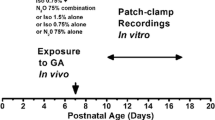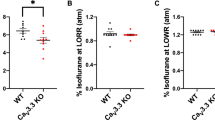Abstract
In the current study, we sought to investigate whether T-type Ca2+ channels (TCCs) in the brain are involved in generating post-anesthetic hyperexcitatory behaviors (PAHBs). We found that younger rat pups (postnatal days 9–11) had a higher incidence of PAHBs and higher PAHB scores than older pups (postnatal days 16–18) during emergence from sevoflurane anesthesia. The power spectrum of the theta oscillations (4 Hz–8 Hz) in the prefrontal cortex was significantly enhanced in younger pups when PAHBs occurred, while there were no significant changes in older pups. Both the power of theta oscillations and the level of PAHBs were significantly reduced by the administration of TCC inhibitors. Moreover, the sensitivity of TCCs in the medial dorsal thalamic nucleus to sevoflurane was found to increase with age by investigating the kinetic properties of TCCs in vitro. TCCs were activated by potentiated GABAergic depolarization with a sub-anesthetic dose of sevoflurane (1%). These data suggest that (1) TCCs in the brain contribute to the generation of PAHBs and the concomitant electroencephalographic changes; (2) the stronger inhibitory effect of sevoflurane contributes to the lack of PAHBs in older rats; and (3) the contribution of TCCs to PAHBs is not mediated by a direct effect of sevoflurane on TCCs.






Similar content being viewed by others
References
Sakai EM, Connolly LA, Klauck JA. Inhalation anesthesiology and volatile liquid anesthetics: focus on isoflurane, desflurane, and sevoflurane. Pharmacotherapy 2005, 25: 1773–1788.
Costi D, Cyna AM, Ahmed S, Stephens K, Strickland P, Ellwood J, et al. Effects of sevoflurane versus other general anaesthesia on emergence agitation in children. Cochrane Database Syst Rev 2014, 12: CD007084.
Moore AD, Anghelescu DL. Emergence delirium in pediatric anesthesia. Paediatr Drugs 2017, 19: 11–20.
Veyckemans F. Excitation phenomena during sevoflurane anaesthesia in children. Curr Opin Anaesthesiol 2001, 14: 339–343.
Vlajkovic GP, Sindjelic RP. Emergence delirium in children: many questions, few answers. Anesth Analg 2007, 104: 84–91.
Kain ZN, Caldwell-Andrews AA, Weinberg ME, Mayes LC, Wang SM, Gaal D, et al. Sevoflurane versus halothane: postoperative maladaptive behavioral changes: a randomized, controlled trial. Anesthesiology 2005, 102: 720–726.
Hauber JA, Davis PJ, Bendel LP, Martyn SV, McCarthy DL, Evans MC, et al. Dexmedetomidine as a rapid bolus for treatment and prophylactic prevention of emergence agitation in anesthetized children. Anesth Analg 2015, 121: 1308–1315.
Aouad MT, Al-Alami AA, Nasr VG, Souki FG, Zbeidy RA, Siddik-Sayyid SM. The effect of low-dose remifentanil on responses to the endotracheal tube during emergence from general anesthesia. Anesth Analg 2009, 108: 1157–1160.
Dalens BJ, Pinard AM, Letourneau DR, Albert NT, Truchon RJ. Prevention of emergence agitation after sevoflurane anesthesia for pediatric cerebral magnetic resonance imaging by small doses of ketamine or nalbuphine administered just before discontinuing anesthesia. Anesth Analg 2006, 102: 1056–1061.
Lim BG, Shen FY, Kim YB, Kim WB, Kim YS, Han HC, et al. Possible role of GABAergic depolarization in neocortical neurons in generating hyperexcitatory behaviors during emergence from sevoflurane anesthesia in the rat. ASN Neuro 2014, 6: 127–136.
Chemin J, Cazade M, Lory P. Modulation of T-type calcium channels by bioactive lipids. Pflug Arch 2014, 466: 689–700.
Varma A, He J, Weissfeld L, Devaskar SU. Postnatal intracerebroventricular exposure to neuropeptide Y causes weight loss in female adult rats. Am J Physiol Regul Integr Comp Physiol 2003, 284: R1560–R1566.
Shen FY, Chen ZY, Zhong W, Ma LQ, Chen C, Yang ZJ, et al. Alleviation of neuropathic pain by regulating T-type calcium channels in rat anterior cingulate cortex. Mol Pain 2015, 11: 8.
Huang L, Keyser BM, Tagmose TM, Hansen JB, Taylor JT, Zhuang H, et al. NNC 55-0396 [(1S,2S)-2-(2-(N-[(3-benzimidazol-2-yl)propyl]-N-methylamino)ethyl)-6-fluoro-1,2, 3,4-tetrahydro-1-isopropyl-2-naphtyl cyclopropanecarboxylate dihydrochloride]: a new selective inhibitor of T-type calcium channels. J Pharmacol Exp Ther 2004, 309: 193–199.
Huguenard JR. Block of T-type Ca(2+) channels is an important action of succinimide antiabsence drugs. Epilepsy Curr 2002, 2: 49–52.
[16] Contreras D. The role of T-channels in the generation of thalamocortical rhythms. CNS Neurol Disord Drug Targets 2006, 5: 571–585.
van Wijngaarden JB, Zucca R, Finnigan S, Verschure PF. The impact of cortical lesions on thalamo-cortical network dynamics after acute ischaemic stroke: a combined experimental and theoretical study. PLoS Comput Biol 2016, 12: e1005048.
Huguenard JR. Low-threshold calcium currents in central nervous system neurons. Annu Rev Physiol 1996, 58: 329–348.
Bough KJ, Gudi K, Han FT, Rathod AH, Eagles DA. An anticonvulsant profile of the ketogenic diet in the rat. Epilepsy Res 2002, 50: 313–325.
Martin JC, Liley DT, Harvey AS, Kuhlmann L, Sleigh JW, Davidson AJ. Alterations in the functional connectivity of frontal lobe networks preceding emergence delirium in children. Anesthesiology 2014, 121: 740–752.
Constant I, Seeman R, Murat I. Sevoflurane and epileptiform EEG changes. Paediatr Anaesth 2005, 15: 266–274.
Mohanram A, Kumar V, Iqbal Z, Markan S, Pagel PS. Repetitive generalized seizure-like activity during emergence from sevoflurane anesthesia. Can J Anaesth 2007, 54: 657–661.
Llinas RR, Ribary U, Jeanmonod D, Kronberg E, Mitra PP. Thalamocortical dysrhythmia: a neurological and neuropsychiatric syndrome characterized by magnetoencephalography. Proc Natl Acad Sci U S A 1999, 96: 15222–15227.
Llinas RR, Steriade M. Bursting of thalamic neurons and states of vigilance. J Neurophysiol 2006, 95: 3297–3308.
Wei H, Bonjean M, Petry HM, Sejnowski TJ, Bickford ME. Thalamic burst firing propensity: a comparison of the dorsal lateral geniculate and pulvinar nuclei in the tree shrew. J Neurosci 2011, 31: 17287–17299.
Hull C, Isaacson JS, Scanziani M. Postsynaptic mechanisms govern the differential excitation of cortical neurons by thalamic inputs. J Neurosci 2009, 29: 9127–9136.
Saalmann YB. Intralaminar and medial thalamic influence on cortical synchrony, information transmission and cognition. Front Syst Neurosci 2014, 8: 83.
Kaila K, Price TJ, Payne JA, Puskarjov M, Voipio J. Cation-chloride cotransporters in neuronal development, plasticity and disease. Nat Rev Neurosci 2014, 15: 637–654.
Aptel H, Hilaire C, Pieraut S, Boukhaddaoui H, Mallie S, Valmier J, et al. The Cav3.2/alpha1H T-type Ca2+ current is a molecular determinant of excitatory effects of GABA in adult sensory neurons. Mol Cell Neurosci 2007, 36: 293–303.
Ben-Ari Y, Gaiarsa JL, Tyzio R, Khazipov R. GABA: a pioneer transmitter that excites immature neurons and generates primitive oscillations. Physiol Rev 2007, 87: 1215–1284.
Song I, Savtchenko L, Semyanov A. Tonic excitation or inhibition is set by GABA(A) conductance in hippocampal interneurons. Nat Commun 2011, 2: 376.
Lecker I, Yin Y, Wang DS, Orser BA. Potentiation of GABAA receptor activity by volatile anaesthetics is reduced by alpha5GABAA receptor-preferring inverse agonists. Br J Anaesth 2013, 110 Suppl 1: i73–i81.
Ries CR, Puil E. Mechanism of anesthesia revealed by shunting actions of isoflurane on thalamocortical neurons. J Neurophysiol 1999, 81: 1795–1801.
Acknowledgements
This work was supported by the National Natural Science Foundation, Beijing, People’s Republic of China (81671058 and 81730031 to YW and 81401089 to MD); the National Research Foundation of Korea grants funded by the Republic of Korea (2019R1I1A1A01057744 to YK); and the Foundation of Shanghai Municipal Science and Technology Commission (19ZR1407500 to FS).
Author information
Authors and Affiliations
Corresponding authors
Ethics declarations
Conflict of interest
The authors claim that there are no conflicts of interest.
Rights and permissions
About this article
Cite this article
Shen, FY., Lim, BG., Wen, W. et al. Role of T-type Calcium Channels in Generating Hyperexcitatory Behaviors during Emergence from Sevoflurane Anesthesia in Neonatal Rats. Neurosci. Bull. 36, 519–529 (2020). https://doi.org/10.1007/s12264-019-00461-x
Received:
Accepted:
Published:
Issue Date:
DOI: https://doi.org/10.1007/s12264-019-00461-x




